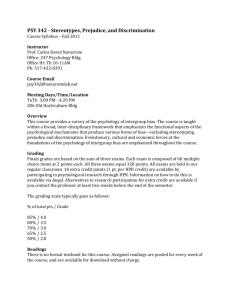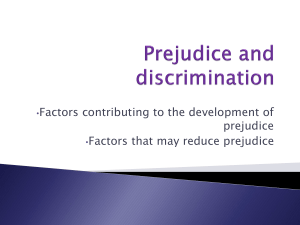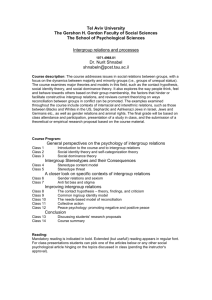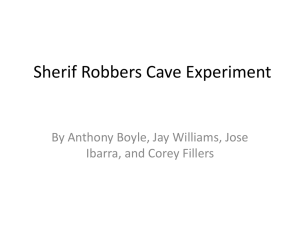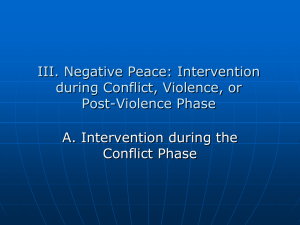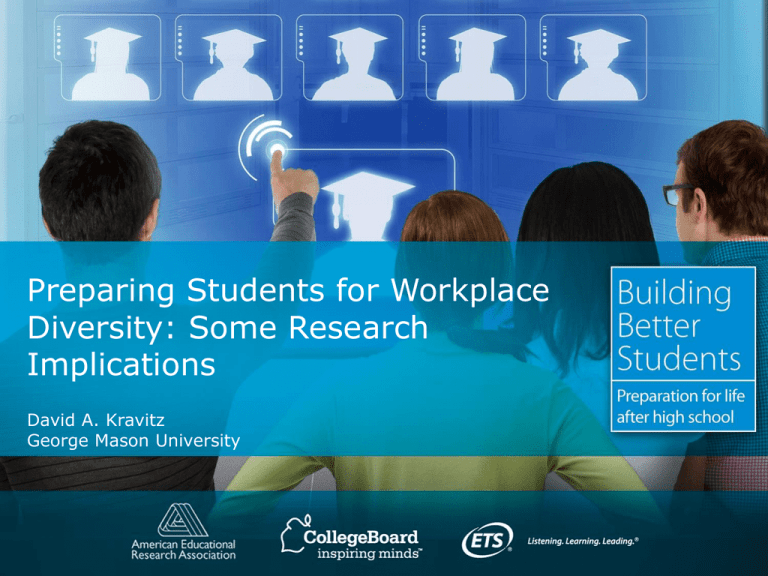
Preparing Students for Workplace
Diversity: Some Research
Implications
David A. Kravitz
George Mason University
Thanks to
•
•
•
•
Paul Gorski
Eden King
Hun Lee
Melina Nardi
Copyright © 2010. All rights reserved.
12/9/2010
2
My Charge
• Explore the implications of
diversity management research
for developing programmatic
non-cognitive interventions to
prepare high school students for
the increased globalization and
diversity of the business world.
Copyright © 2010. All rights reserved.
12/9/2010
3
Validity of Underlying Assumption
• The charge assumes that
business will be increasingly
global and the workforce
increasingly diverse.
• Is this true?
Copyright © 2010. All rights reserved.
12/9/2010
4
Globalization of Business
U.S. International Trade in Goods and Services
(Millions of dollars)
Year
Exports
Imports
Total
1993
642,863
713,174
1,356,037
1998
933,174
1,099,314
2,032,488
2003
1,019,897
1,514,080
2,533,977
2008
1,839,012
2,537,814
4,376,826
Copyright © 2010. All rights reserved.
12/9/2010
5
Cultural Dimensions
• The U.S. differs from most of the world in
our cultural assumptions along a number
of dimensions (e.g., locus of control,
individualism/collectivism, time
orientation).
– These differences must be understood when
doing business with people in other countries.
– These differences also imply that immigration
will lead to increased cultural diversity in the
U.S. workforce.
Copyright © 2010. All rights reserved.
12/9/2010
6
Immigration to the U.S.
• In 2009, 38.5 million people in the
U.S. (about 12.5% of the population)
were foreign-born.
• Many others residents are children of
immigrants. Thus, their cultural
assumptions are based on both U.S.
culture and their parents’ cultures.
Copyright © 2010. All rights reserved.
12/9/2010
7
U.S. Population: Race & Ethnicity
Group
2010
2030
2050
White alone
64.7
55.5
46.3
Black alone
12.2
12.2
11.8
Asian alone
4.5
6.2
7.6
All other races
2.4
3.2
4.0
16.0
23.0
30.2
Non-Hispanic
Hispanic
(any/all races)
Copyright © 2010. All rights reserved.
12/9/2010
8
U.S. Population: Age & Sex
Copyright © 2010. All rights reserved.
12/9/2010
9
U.S. Religious Affiliations
Religion
1990
2008
Catholic
26.2
25.1
Other Christian
60.0
50.9
No Religion
8.2
15.0
Other Religions
3.3
3.9
No Response
2.3
5.2
Kosmin & Keysar (2009)
Copyright © 2010. All rights reserved.
12/9/2010
10
U.S. Sexual Orientation
• Due to the biological basis of sexual
attraction, I assume that the proportion
of the population that is not heterosexual
is not changing.
• Due to cultural changes, individuals who
are not heterosexual are increasingly
open about their sexual orientation and
are demanding the elimination of sexual
orientation discrimination.
Copyright © 2010. All rights reserved.
12/9/2010
11
Conclusion
• U. S. business is becoming
increasingly global and the
workforce increasingly
diverse.
• Why is this a problem?
Copyright © 2010. All rights reserved.
12/9/2010
12
Bias: A Human Weakness
• Bias (prejudice, stereotyping,
discrimination) toward those who differ
from oneself (outgroup members) exists
for many reasons.
– Automatic preference for the in-group
• Evolution-based
• Social identity
– Perceived realistic and symbolic threats
– The need to simplify reality (stereotyping)
– Ongoing influence of historical events
Copyright © 2010. All rights reserved.
12/9/2010
13
Implication
• Today’s students will need to work
successfully with others who differ
from them in many ways.
• Dealing with different cultures and
different people can be challenging.
• We need to prepare our students –
help them become more culturally
competent.
Copyright © 2010. All rights reserved.
12/9/2010
14
Bennett’s Model
• The Development Model of Intercultural
Sensitivity posits six stages of cultural
competence.
– Ethnocentric
• Denial, Defense, Minimization
– Ethnorelative
• Acceptance, Adaptation, Integration
• The challenge is to help student attain one
of the ethnorelative stages.
Copyright © 2010. All rights reserved.
12/9/2010
15
What is cultural competence?
Sue’s Model
• Sue’s (2001) multidimensional model
of cultural competence includes three
dimensions of cultural competence
– Foci (individual, professional,
organizational, societal)
– Group-specific attributes (appropriate
action depends on the target group)
– Components (attitudes, knowledge,
skills)
Copyright © 2010. All rights reserved.
12/9/2010
16
Workplace Diversity Research
• What can we learn from research on
workplace diversity?
• Very little. (Bah humbug!)
– Wrong level of analysis and criterion
– Inability to draw causal conclusions
about specific interventions or specific
aspects of interventions
– Focus on cognitive interventions (e.g.,
most diversity training)
Copyright © 2010. All rights reserved.
12/9/2010
17
One Useful Research Stream
• Diversity climate has positive effects
– Diversity climate is employees' shared
perceptions that the organization is committed
to eliminating discrimination and fostering
diversity.
– A positive diversity climate is associated with
greater organizational commitment and lower
turnover among all identity groups. It may
eliminate the negative effects sometimes
created by diversity.
• Buttner et al. (2010); Gonzalez & DeNisi (2009);
Copyright © 2010. All rights reserved.
McKay et al. (2007)
12/9/2010
18
So???
Should I sit down and shut up?
• As the charge was written, I have
found relatively little.
• However, the behavioral and
psychological work that underlies
research on workplace diversity has
a bit more to offer.
Copyright © 2010. All rights reserved.
12/9/2010
19
Psychological Bases
• “Perhaps the most important contributions that social
psychologists have made involve the potential for
improving intergroup relations. … We have developed
excellent models to work from, but know little
about how to implement programs that will
make a real difference.”
Stangor, 2009, p. 10
• Notwithstanding the enormous literature on prejudice
… the literature does not reveal whether, when,
and why interventions reduce prejudice [bias] in
the world.
Paluck & Green, 2009, p. 360
• Well, that’s discouraging!
Copyright © 2010. All rights reserved.
12/9/2010
20
Paluck & Green (2009)
• Massive review of the bias reduction
literature (900 reports)
• A reasonably amount of evidence
supports the efficacy of
cooperation, the common
ingroup identity model, and the
contact hypothesis.
Copyright © 2010. All rights reserved.
12/9/2010
21
Cooperative Learning
• Teams work together and each team
member is responsible for learning
and helping the others learn.
• Of the 107 randomized field
experiments found by Paluck and
Green (2009), 36 dealt with
cooperative learning.
Copyright © 2010. All rights reserved.
12/9/2010
22
Cooperative Learning - Results
• Ginsburg-Block, Rohrbeck & Fantuzzo (2006)
• Meta-analysis of 30 studies of the effects of peerassisted learning (PAL) on social outcomes
among elementary school students.
• Significant effect: d = 0.28.
• Effect was stronger when the group had
interdependent group reward contingencies,
opportunities for student autonomy, and
structured peer interactions in which students
were provided with roles.
Copyright © 2010. All rights reserved.
12/9/2010
23
Cooperative Learning - Results
• Roseth, Johnson & Johnson (2008).
• Meta-analysis of the effect of goal structures
on quality of peer relationships among early
adolescents. Included 148 studies.
• “Cooperative goal structures were associated
with 0.48 standard deviation increase in
positive peer relationships over competitive
goal structures … [and] 0.42 standard
deviation increase … over individualistic goal
structures.”
Copyright © 2010. All rights reserved.
12/9/2010
24
Contact
• Pettigrew & Tropp (2006) metaanalysis of the relation between
contact and prejudice (713 samples)
– Significant relation (-0.21)
– Stronger effect in rigorous research
– Stronger effect when contact conditions
were optimal (a la Allport), but still
significant under non-optimal conditions
Copyright © 2010. All rights reserved.
12/9/2010
25
Contact – Secondary Transfer
• Tausch et al. (2010)
• Four field studies using different targets,
respondents, and methodologies found
that contact with one outgroup leads to
more positive attitudes toward a
secondary outgroup.
– For example, Black and White Texas college
students who had more contact with the other
group were less biased against Vietnamese
and Asian Indians.
Copyright © 2010. All rights reserved.
12/9/2010
26
Contact – Potential Danger
• Paolini, Harwood & Rubin (2010)
• Research has shown that high salience of
an outgroup’s category leads to negative
interactions, presumably due to anxiety.
• Paolini et al. found that negative
interactions stimulated greater awareness
of the category.
• Combined, this implies that contact has a
negative bias.
Copyright © 2010. All rights reserved.
12/9/2010
27
Contact - Conclusion
• Positive contact can decrease prejudice
toward the partner’s group and even
toward other outgroups.
• This effect is particularly strong when
there is equal status between the groups
in the situation, they have a common
goal, they cooperate, and the positive
relationship has the support of authorities,
law, or custom (Allport’s optimal
conditions).
Copyright © 2010. All rights reserved.
12/9/2010
28
Common Ingroup Identity Model
• Gaertner & Dovidio (2000)
• Biases toward out-group members can
be decreased when the individual
creates a superordinate group that
includes both the original in-group and
the out-group.
• I have not found a meta-analysis, but a
number of studies have been
supportive.
Copyright © 2010. All rights reserved.
12/9/2010
29
Timely Example
• The Pentagon recently released their
survey of troop opinions about the impact
of repealing “Don’t Ask, Don’t Tell.”
• The report includes tables that show how
responses vary depending on whether the
respondent is aware that s/he is currently
working with a gay or lesbian colleague.
– I presume this combines contact, cooperation,
and a common in-group identity.
Copyright © 2010. All rights reserved.
12/9/2010
30
Troop Prediction of Impact of
DADT Repeal on Performance
Q71c. If DADT is repealed and you are working with a Service member in
your immediate unit who has said he or she is gay or lesbian, how, if at all,
would it affect your immediate unit's effectiveness at completing its mission...
In an intense combat situation?
Currently
serve with
Never
served with
Very positive or positive
16.0
11.5
Equally P&N + no effect
57.9
52.5
Negative or very negative
26.0
35.9
Effect
Copyright © 2010. All rights reserved.
12/9/2010
31
Summary
• Research suggests that bias will be
decreased by
– A positive diversity climate
– Positive cooperative contact
– Creation of a common in-group identity
• Given this, what are some programmatic
non-cognitive interventions school
systems or other organizations could
create to prepare high school students for
the increased diversity of their work lives?
Copyright © 2010. All rights reserved.
12/9/2010
32
Your Turn
• Please take a couple of minutes to write
down possible approaches on the note
card you have been given. This can
include actual programs with which you
are familiar.
• Then talk with your colleagues to flesh-out
your ideas.
• We’ll take a few minutes to report out and
I’ll ask you to turn in the cards at the end.
Copyright © 2010. All rights reserved.
12/9/2010
33
Questions or Comments?
Copyright © 2010. All rights reserved.
34
Print References
•
•
•
•
•
•
•
•
•
•
•
•
•
Bennett, J. M., & Bennett, M. J. (2004). Developing intercultural sensitivity: An integrative approach to global and domestic
diversity. In D. Landis, J. M. Bennett & M. J. Bennett (Eds.), Handbook of intercultural training (3rd ed., pp. 147-165). Thousand
Oaks, CA: Sage.
Buttner, E. H., Lowe, K. B., & Billings-Harris, L. (2010). Diversity climate impact on employee of color outcomes: does justice
matter? Career Development International, 15(3), 239-258.
Gaertner, S. L., & Dovidio, J. F. (2000). Reducing intergroup bias: The common ingroup identity model. Philadelphia, PA: Psychology
Press.
Ginsburg-Block, M. D., Rohrbeck, C. A., & Fantuzzo, J. W. (2006). A meta-analytic review of social, self-concept, and behavioral
outcomes of peer-assisted learning. Journal of Educational Psychology, 98(4), 732-749.
Gonzalez, J. A., & DeNisi, A. S. (2009). Cross-level effects of demography and diversity climate on organizational attachment and
firm effectiveness. Journal of Organizational Behavior, 30(1), 21-40.
Kosmin, B. A. & Keysar, A. (2009). American religious identification survey (ARIS) 2008. Hartford, CT: Trinity College.
Paluck, E. L., & Green, D. P. (2009). Prejudice reduction: What works? A review and assessment of research and practice. Annual
Review of Psychology, 60, 339-368.
Paolini, S., Harwood, J., & Rubin, M. (2010). Negative intergroup contact makes group memberships salient: Explaining why
intergroup conflict endures. Personality and Social Psychology Bulletin, 36(12), 1723-1738.
Pettigrew, T. F., & Tropp, L. R. (2006). A meta-analytic test of intergroup contact theory. Journal of Personality and Social
Psychology, 90(5), 751-783.
Roseth, C. J., Johnson, D. W., & Johnson, R. T. (2008). Promoting early adolescents' achievement and peer relationships: The
effects of cooperative, competitive, and individualistic goal structures. Psychological Bulletin, 134(2), 223-246.
Stangor, C. (2009). The study of stereotyping, prejudice, and discrimination within social psychology: A quick history of theory and
research. In T. D. Nelson (Ed.), Handbook of prejudice, stereotyping, and discrimination (pp. 1-22). New York: Psychology Press.
Sue, D. W. (2001). Multidimensional facets of cultural competence. The Counseling Psychologist, 29(6), 790-821.
Tausch, N., Hewstone, M., Kenworthy, J. B., Psaltis, C., Schmid, K., Popan, J. R., et al. (2010). Secondary transfer effects of
intergroup contact: Alternative accounts and underlying processes. Journal of Personality and Social Psychology, 99(2), 282-302.
Copyright © 2010. All rights reserved.
12/9/2010
35
Internet References
•
U.S. International Trade:
–
•
U.S. Foreign born
–
•
http://www.census.gov/population/www/projections/summarytables.html
U.S. Population Age & Sex
–
•
http://www.census.gov/prod/2010pubs/acsbr09-15.pdf
U.S. Population Race & Ethnicity
–
•
http://www.bea.gov/international/index.htm
http://www.census.gov/population/www/projections/regdivpyramid.html
U.S. Department of Defense: Don’t Ask, Don’t Tell
–
http://www.defense.gov/home/features/2010/0610_gatesdadt/
Copyright © 2010. All rights reserved.
12/9/2010
36


